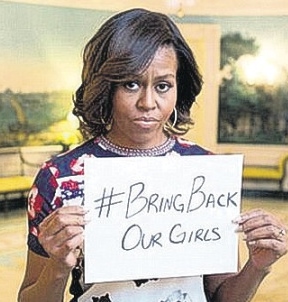Virtue signalling: Difference between revisions
Amwelladmin (talk | contribs) No edit summary |
Amwelladmin (talk | contribs) No edit summary |
||
| Line 1: | Line 1: | ||
[[File:Bring back our girls.jpg|thumb|any sign yet?]] | [[File:Bring back our girls.jpg|thumb|any sign yet?]] | ||
[[Virtue-signalling]] is making a statement that looks controversial but is made predominantly to garner approval. The | [[Virtue-signalling]] is making a statement that looks controversial but is made predominantly to garner approval. The best way of doing that is to make your controversial statement to an audience whom you believe will uniformly agree with it. It’s a form of preaching to the choir. | ||
Social media is intrinsically excellent medium for virtue signaling, because you choose | Social media is intrinsically excellent medium for virtue signaling, because it costs nothing to make a statement, and you can choose & filter your audience (or it chooses and filters you) based on pre-determined proclivities. | ||
The cause célèbre of virtue signaling followed Boko Haram’s kidnapping of 276 | The cause célèbre of virtue signaling followed Boko Haram’s kidnapping of 276 girls from a Secondary School in Nigeria in 2o14. This was a categorically horrific act, to which most of the networked world responded, on Twitter, with the hashtag #BringBackOurGirls, often accompanied by a photo of individual (the most famous was Michelle Obama), moon faced, holding up the hashtag on a piece of paper. Everyone joined in. Easy, cheap, filling oneself with a sense of lofty righteousness and achieving precisely nothing. | ||
The point isn’t to criticize the sentiment — what kind of monster<ref>Well, obviously a member of Boko Haram, of course. | The point isn’t to criticize the sentiment — what kind of monster<ref>Well, obviously a member of Boko Haram, of course. But you get the point.</ref> could do that? — but to ask what practical good it does? Would a worldwide crush of hashtags lead a religious fundamentalist to the error of his ways<ref>No, sayeth Wikipedia: “However, with limited action and success after initial protests in 2014, little has been accomplished through social media regarding results. As of January 13, 2017, 195 of the 276 girls are still in captivity, close to three years after the kidnappings.”</ref>? Or was that not really the point, but to visibly, righteously, show concern in a costless but [[bragadocious]] way? | ||
{{ref}} | {{ref}} | ||
Revision as of 13:28, 21 August 2017

Virtue-signalling is making a statement that looks controversial but is made predominantly to garner approval. The best way of doing that is to make your controversial statement to an audience whom you believe will uniformly agree with it. It’s a form of preaching to the choir.
Social media is intrinsically excellent medium for virtue signaling, because it costs nothing to make a statement, and you can choose & filter your audience (or it chooses and filters you) based on pre-determined proclivities.
The cause célèbre of virtue signaling followed Boko Haram’s kidnapping of 276 girls from a Secondary School in Nigeria in 2o14. This was a categorically horrific act, to which most of the networked world responded, on Twitter, with the hashtag #BringBackOurGirls, often accompanied by a photo of individual (the most famous was Michelle Obama), moon faced, holding up the hashtag on a piece of paper. Everyone joined in. Easy, cheap, filling oneself with a sense of lofty righteousness and achieving precisely nothing.
The point isn’t to criticize the sentiment — what kind of monster[1] could do that? — but to ask what practical good it does? Would a worldwide crush of hashtags lead a religious fundamentalist to the error of his ways[2]? Or was that not really the point, but to visibly, righteously, show concern in a costless but bragadocious way?
References
- ↑ Well, obviously a member of Boko Haram, of course. But you get the point.
- ↑ No, sayeth Wikipedia: “However, with limited action and success after initial protests in 2014, little has been accomplished through social media regarding results. As of January 13, 2017, 195 of the 276 girls are still in captivity, close to three years after the kidnappings.”